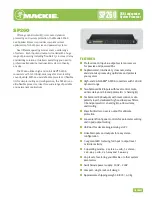
Configuring the Stack
77
short time to be forwarded, but all error packets except fragments are
propagated.
■
Store and Forward
— Received packets are buffered entirely before
they are forwarded, which ensures that only good packets are
forwarded to their destination. With Store and Forward, packets take
slightly longer to be forwarded than with Fast Forward and Fragment
Free, but no errors are propagated.
■
Intelligent
— The stack monitors the amount of error traffic on the
network and changes the forwarding mode accordingly. Normally, the
stack is in Fast Forward mode. If the stack detects an error rate of
greater than 20 errored frames per second, the forwarding mode is
set to Store and Forward. It will return to Fast Forward mode once the
error rate drops to 1 errored frame per second.
Units in the Switch 3300/630 family only support the Store and Forward
forwarding mode. If the stack is set to another forwarding mode, these
units use the Store and Forward forwarding mode.
Spanning Tree
Enabled / Disabled
Allows you to specify whether the stack uses the Spanning Tree Protocol
(STP). Using STP makes your network more resilient to link failure and also
provides a protection from loops — one of the major causes of broadcast
storms; for more information, see
“Spanning Tree Protocol”
on
page 193
.
CAUTION:
If you enable STP, the stack takes several seconds to configure
itself. During this time, you cannot communicate with the stack.
You cannot enable STP if you have set up resilient links on any Switch
units in your stack. For more information about resilient links, see
“Setting Up Resilient Links”
on
page 79
.
Broadcast Storm Control
Enabled / Disabled
Allows you to specify whether the stack uses Broadcast Storm Control. If
Broadcast Storm Control is enabled, the stack automatically creates an
alarm for each port to monitor the level of broadcast traffic on that port.
If the broadcast traffic level rises to 2976 frames per second, the
broadcast traffic on the port is blocked until the broadcast traffic level
drops to 1488 frames per second.
Summary of Contents for SuperStack II
Page 12: ......
Page 18: ......
Page 42: ......
Page 154: ...154 CHAPTER 4 WORKING WITH THE COMMAND LINE INTERFACE ...
Page 156: ......
Page 162: ...162 CHAPTER 5 PORT TRUNKS ...
Page 169: ...VLANs and Your Switch 169 Figure 32 Forwarding unknown 802 1Q tags ...
Page 173: ...VLAN Configuration for Beginners 173 Figure 34 Simple example Untagged connections using hubs ...
Page 180: ...180 CHAPTER 6 VIRTUAL LANS VLANS ...
Page 188: ...188 CHAPTER 7 FASTIP ...
Page 200: ...200 CHAPTER 9 SPANNING TREE PROTOCOL Figure 49 STP configurations ...
Page 210: ...210 CHAPTER 10 RMON ...
Page 211: ...IV PROBLEM SOLVING Chapter 11 Problem Solving ...
Page 212: ......
Page 224: ...224 CHAPTER 11 PROBLEM SOLVING ...
Page 226: ......
















































